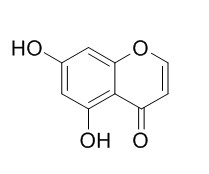5,7-Dihydroxychromone
5,7-Dihydroxychromone is one of the active compounds that may contribute to regulate blood glucose levels. 5,7-Dihydroxychromone exerts neuroprotective effect against 6-OHDA-induced oxidative stress and apoptosis by activating Nrf2/ARE signal.
Inquire / Order:
manager@chemfaces.com
Technical Inquiries:
service@chemfaces.com
Tel:
+86-27-84237783
Fax:
+86-27-84254680
Address:
1 Building, No. 83, CheCheng Rd., Wuhan Economic and Technological Development Zone, Wuhan, Hubei 430056, PRC
Providing storage is as stated on the product vial and the vial is kept tightly sealed, the product can be stored for up to
24 months(2-8C).
Wherever possible, you should prepare and use solutions on the same day. However, if you need to make up stock solutions in advance, we recommend that you store the solution as aliquots in tightly sealed vials at -20C. Generally, these will be useable for up to two weeks. Before use, and prior to opening the vial we recommend that you allow your product to equilibrate to room temperature for at least 1 hour.
Need more advice on solubility, usage and handling? Please email to: service@chemfaces.com
The packaging of the product may have turned upside down during transportation, resulting in the natural compounds adhering to the neck or cap of the vial. take the vial out of its packaging and gently shake to let the compounds fall to the bottom of the vial. for liquid products, centrifuge at 200-500 RPM to gather the liquid at the bottom of the vial. try to avoid loss or contamination during handling.
Heliyon.2024, 10(12):e31722.
Int J Mol Sci.2020, 21(22):8816.
Front Pharmacol.2020, 11:566490.
Phytomedicine.2023, 116:154841.
J Ethnopharmacol.2025, 350:120002.
Plants (Basel).2022, 11(21):2947.
Plants (Basel).2020, 9(11):1422.
Chem Biodivers.2023, 20(12):e202301461.
The Catharanthus Genome2022,35-83.
Chinese Journal of Hospital Pharmacy2020, 40(7)
Related and Featured Products
Life Sci. 2015 Jun 1;130:25-30.
Neuroprotection against 6-OHDA-induced oxidative stress and apoptosis in SH-SY5Y cells by 5,7-Dihydroxychromone: Activation of the Nrf2/ARE pathway.[Pubmed:
25818191]
The aim of this study was to prove the neuroprotective effect of 5,7-Dihydroxychromone (DHC) through the Nrf2/ARE signaling pathway. To elucidate the mechanism, we investigated whether 6-hydroxydopamine (6-OHDA)-induced neurotoxicity in SH-SY5Y cells could be attenuated by DHC via activating the Nrf2/ARE signal and whether 5,7-Dihydroxychromone could down-regulate 6-OHDA-induced excessive ROS generation
METHODS AND RESULTS:
To evaluate the neuroprotective effect of 5,7-Dihydroxychromone against 6-OHDA-induced apoptosis, FACS analysis was performed using PI staining. The inhibitory effect of 5,7-Dihydroxychromone against 6-OHDA-induced ROS generation was evaluated by DCFH-DA staining assay. Additionally, translocation of Nrf2 to the nucleus and increased Nrf2/ARE binding activity, which subsequently resulted in the up-regulation of the Nrf2-dependent antioxidant gene expressions including HO-1, NQO1, and GCLc, were evaluated by Western blotting and EMSA.Pre-treatment of 5,7-Dihydroxychromone, one of the constituents of Cudrania tricuspidata, significantly protects 6-OHDA-induced neuronal cell death and ROS generation. Also, DHC inhibited the expression of activated caspase-3 and caspase-9 and cleaved PARP in 6-OHDA-induced SH-SY5Y cells. 5,7-Dihydroxychromone induced the translocation of Nrf2 to the nucleus and increased Nrf2/ARE binding activity which results in the up-regulation of the expression of Nrf2-dependent antioxidant genes, including HO-1, NQO1, and GCLc. The addition of Nrf2 siRNA abolished the neuroprotective effect of DHC against 6-OHDA-induced neurotoxicity and the expression of Nrf2-mediated antioxidant genes.
CONCLUSIONS:
Activation of Nrf2/ARE signal by 5,7-Dihydroxychromone exerted neuroprotective effects against 6-OHDA-induced oxidative stress and apoptosis. This finding will give an insight that activating Nrf2/ARE signal could be a new potential therapeutic strategy for neurodegenerative disease.
Biosci Biotechnol Biochem. 2014;78(8):1392-401.
Anti-diabetic properties of Daphniphyllum macropodum fruit and its active compound.[Pubmed:
25130743]
Among the compounds isolated, 5,7-Dihydroxychromone potently induced the differentiation of mouse 3T3-L1 preadipocytes. DME and 5,7-Dihydroxychromone increased PPARγ and liver X receptor α (LXRα) mRNA expression levels.
METHODS AND RESULTS:
To determine whether the adipogenic effects we observed might affect serum glucose levels, we undertook in vivo experiment using streptozotocin-/high-fat diet-induced type 2 diabetes mouse model. DME supplementation reduced serum glucose, total cholesterol, and triacylglycerol levels in diabetes mice.
CONCLUSIONS:
These results suggest that DME may be useful for the prevention and treatment of type 2 diabetes mellitus. Moreover, it was proposed that 5,7-Dihydroxychromone isolated from DME is one of the active compounds that may contribute to regulate blood glucose levels.



